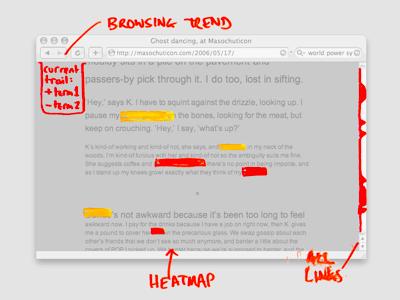
Idea #3 is back to smell. Smell, as I said, is partly like flavour, only passive and it spreads over a whole space that we move through. It’s to do with probabilities, it’s more visceral and automatic, a bit pre-emptive, and moving through it is all to do with rates of change.
Now, you know how Google calculated pagerank, way back when? They used the random surfer algorithm: You visit a page, follow a random link from there, and repeat around 10 times.
Okay, starting at a link from the current page let’s take the terms from all the pages encountered in all possible random surfs, rooted there, and add them together. Weight them according to what’s most likely to be encountered. Now this means that a page that talks about a topic a little two hops away will be the same as one that talks a lot about a topic three hops away… but that’s smell for you.
Now let’s make it so that you can highlight any words on the page and it’ll search Google for those words and calculate the smell aggregated over the distant pages for that set of search results
What we want to include is the sense of moving towards or away a particular smell. Really, smell is like a barometer. Relative to your journey so far, what is there a lot more or less of, down all those links? Let’s show that instead. that way, when you’re browsing you could be navigating towards a particular topic.
Finally we want to include some concept of automaticity. Let’s calculate the user’s path through the smell-space so far, and bring to their attention any links which continue the current trends: If you’re following the smell-trail to greater uses of some term, any links that follow that trend should be highlighted, and that’ll encourage you to sample them with the flavour tool.
That’s enough smelling and tasting.